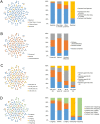Using molecular network analysis to explore the characteristics of HIV-1 transmission in a China-Myanmar border area
- PMID: 35522692
- PMCID: PMC9075624
- DOI: 10.1371/journal.pone.0268143
Using molecular network analysis to explore the characteristics of HIV-1 transmission in a China-Myanmar border area
Abstract
Background: The China-Myanmar border area is considered a hot spot of active HIV-1 recombination in Southeast Asia. To better understand the characteristics of HIV-1 transmission in this area, a cross-sectional HIV-1 molecular epidemiological survey was conducted in Baoshan Prefecture of Yunnan Province.
Methods: In total, 708 newly reported HIV-1 cases in Baoshan Prefecture from 2019 to 2020 were included in this study. HIV-1 gag, pol and env genes were sequenced, and the spatial and demographic distributions of HIV-1 genotypes were analyzed. The characteristics of HIV-1 transmission were investigated using the HIV-1 molecular network method.
Results: In the 497 samples with genotyping results, 19 HIV-1 genotypes were found, with URFs being the predominant strains (30.2%, 150/497). The main circulating HIV-1 strains were mostly distributed in the northern area of Baoshan. URFs were more likely identified in Burmese individuals, intravenous drug users and those younger than 50 years old. CRF08_BC was more likely detected in farmers and those of Han ethnicity, CRF01_AE in the young and those of Han ethnicity, and CRF07_BC in the subpopulation with junior middle school education and higher. Moreover, CRF118_BC and CRF64_BC were more likely found in the subpopulation aged ≥40 years and ≥50 years, respectively. Among 480 individuals with pol sequence detection, 179 (37.3%) were grouped into 78 clusters, with Baoshan natives being more likely to be in the network. The proportion of the linked individuals showed significant differences when stratified by the regional origin, marital status, age and county of case reporting. In the molecular network, recent infections were more likely to occur among nonfarmers and individuals aged below 30 years.
Conclusions: HIV-1 genetics has become complex in Baoshan. HIV-1 molecular network analysis provided transmission characteristics in the local area, and these findings provided information to prioritize transmission-reduction interventions.
Conflict of interest statement
The authors have declared that no competing interests exist.
Figures




Similar articles
-
Using molecular network analysis to understand current HIV-1 transmission characteristics in an inland area of Yunnan, China.Epidemiol Infect. 2023 Jul 18;151:e124. doi: 10.1017/S0950268823001140. Epidemiol Infect. 2023. PMID: 37462024 Free PMC article.
-
Spatial clusters of HIV-1 genotypes in a recently infected population in Yunnan, China.BMC Infect Dis. 2019 Jul 29;19(1):669. doi: 10.1186/s12879-019-4276-9. BMC Infect Dis. 2019. PMID: 31357947 Free PMC article.
-
Emerging variability in HIV-1 genetics among recently infected individuals in Yunnan, China.PLoS One. 2013;8(3):e60101. doi: 10.1371/journal.pone.0060101. Epub 2013 Mar 26. PLoS One. 2013. PMID: 23555898 Free PMC article.
-
HIV-1 Molecular Networks and Pretreatment Drug Resistance at the Frontier of Yunnan Province, China.AIDS Res Hum Retroviruses. 2024 Dec;40(12):701-712. doi: 10.1089/AID.2023.0124. Epub 2024 Jul 16. AIDS Res Hum Retroviruses. 2024. PMID: 38959124
-
Prevalence of Different Genotypes of HIV-1 in Injection Drug Users in China: A Systematic Review and Meta-Analysis.Curr HIV Res. 2019;17(4):240-257. doi: 10.2174/1570162X17666190919115036. Curr HIV Res. 2019. PMID: 31538898
Cited by
-
Prevalence of drug resistance mutations in low-level viremia patients under antiretroviral therapy in Southwestern China: a cross-sectional study.J Antimicrob Chemother. 2025 Apr 2;80(4):947-954. doi: 10.1093/jac/dkaf017. J Antimicrob Chemother. 2025. PMID: 39835338 Free PMC article.
-
Characterizing HIV-1 transmission by genetic cluster analysis among newly diagnosed patients in the China-Myanmar border region from 2020 to 2023.Emerg Microbes Infect. 2024 Dec;13(1):2409319. doi: 10.1080/22221751.2024.2409319. Epub 2024 Sep 30. Emerg Microbes Infect. 2024. PMID: 39315943 Free PMC article.
-
Exploring Dynamic Changes in HIV-1 Molecular Transmission Networks and Key Influencing Factors: Cross-Sectional Study.JMIR Public Health Surveill. 2024 May 29;10:e56593. doi: 10.2196/56593. JMIR Public Health Surveill. 2024. PMID: 38810253 Free PMC article.
-
HIV molecular transmission networks among students in Guangxi: unraveling the dynamics of student-driven HIV epidemic.Emerg Microbes Infect. 2025 Dec;14(1):2459142. doi: 10.1080/22221751.2025.2459142. Epub 2025 Feb 7. Emerg Microbes Infect. 2025. PMID: 39869005 Free PMC article.
-
Exploring and Predicting the Drivers of Ongoing HIV-1 Transmission in Guangyuan, Sichuan.Infect Drug Resist. 2023 Dec 6;16:7467-7484. doi: 10.2147/IDR.S421763. eCollection 2023. Infect Drug Resist. 2023. PMID: 38089963 Free PMC article.
References
Publication types
MeSH terms
LinkOut - more resources
Full Text Sources
Medical
Molecular Biology Databases

